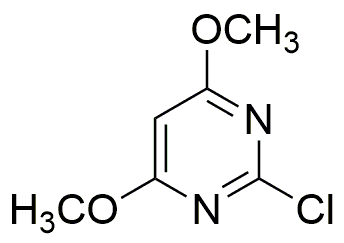2-Chloro-4,6-dimethoxypyrimidine is widely utilized in research focused on:
- Pharmaceutical Development: This compound serves as an important intermediate in the synthesis of various pharmaceuticals, particularly in the development of antiviral and anticancer agents.
- Agricultural Chemicals: It is used in the formulation of herbicides and fungicides, helping to enhance crop protection and yield in the agricultural sector.
- Biochemical Research: Researchers leverage its properties to study enzyme inhibition and cellular processes, contributing to advancements in biochemistry and molecular biology.
- Material Science: The compound is explored for its potential in developing new materials with specific electronic or optical properties, useful in electronics and photonics.
- Analytical Chemistry: It is utilized as a standard in analytical methods for detecting and quantifying related compounds, aiding in quality control and regulatory compliance.
Informations générales
Propriétés
Sécurité et réglementation
Applications
2-Chloro-4,6-dimethoxypyrimidine is widely utilized in research focused on:
- Pharmaceutical Development: This compound serves as an important intermediate in the synthesis of various pharmaceuticals, particularly in the development of antiviral and anticancer agents.
- Agricultural Chemicals: It is used in the formulation of herbicides and fungicides, helping to enhance crop protection and yield in the agricultural sector.
- Biochemical Research: Researchers leverage its properties to study enzyme inhibition and cellular processes, contributing to advancements in biochemistry and molecular biology.
- Material Science: The compound is explored for its potential in developing new materials with specific electronic or optical properties, useful in electronics and photonics.
- Analytical Chemistry: It is utilized as a standard in analytical methods for detecting and quantifying related compounds, aiding in quality control and regulatory compliance.
Documents
Fiches de données de sécurité (FDS)
La FDS fournit des informations de sécurité complètes sur la manipulation, le stockage et l’élimination du produit.
Spécifications du produit (PS)
Le PS fournit une description complète des propriétés du produit, notamment sa composition chimique, son état physique, sa pureté et les exigences de stockage. Il détaille également les plages de qualité acceptables et les applications prévues du produit.
Certificats d'analyse (COA)
Recherchez des certificats d'analyse (COA) en saisissant le numéro de lot du produit. Les numéros de lot et de lot se trouvent sur l'étiquette d'un produit, après les mots « Lot » ou « Lot de fabrication ».
Numéro de catalogue
Numéro de lot/série
Certificats d'origine (COO)
Ce certificat d'exploitation confirme le pays dans lequel le produit a été fabriqué, et détaille également les matériaux et composants utilisés et s'il est issu de sources naturelles, synthétiques ou autres sources spécifiques. Ce certificat peut être requis pour les douanes, le commerce et la conformité réglementaire.
Numéro de catalogue
Numéro de lot/série
Fiches de données de sécurité (FDS)
La FDS fournit des informations de sécurité complètes sur la manipulation, le stockage et l’élimination du produit.
DownloadSpécifications du produit (PS)
Le PS fournit une description complète des propriétés du produit, notamment sa composition chimique, son état physique, sa pureté et les exigences de stockage. Il détaille également les plages de qualité acceptables et les applications prévues du produit.
DownloadCertificats d'analyse (COA)
Recherchez des certificats d'analyse (COA) en saisissant le numéro de lot du produit. Les numéros de lot et de lot se trouvent sur l'étiquette d'un produit, après les mots « Lot » ou « Lot de fabrication ».
Numéro de catalogue
Numéro de lot/série
Certificats d'origine (COO)
Ce certificat d'exploitation confirme le pays dans lequel le produit a été fabriqué, et détaille également les matériaux et composants utilisés et s'il est issu de sources naturelles, synthétiques ou autres sources spécifiques. Ce certificat peut être requis pour les douanes, le commerce et la conformité réglementaire.


